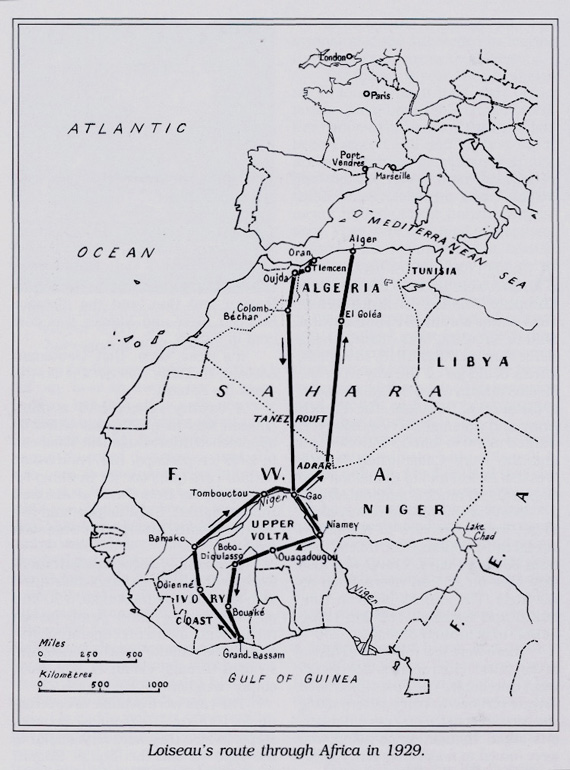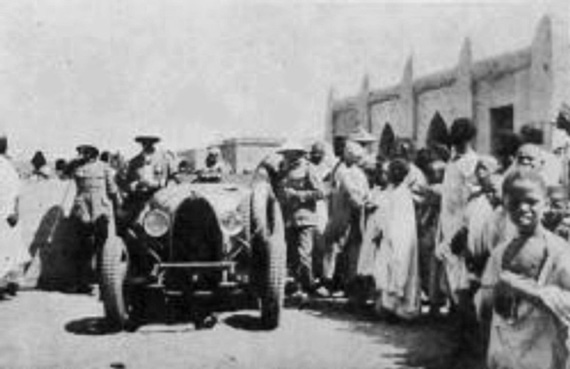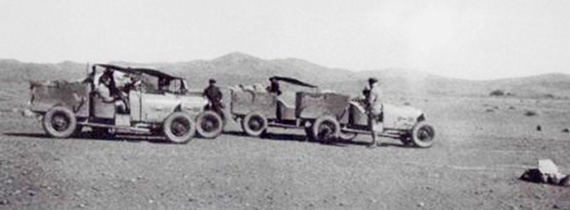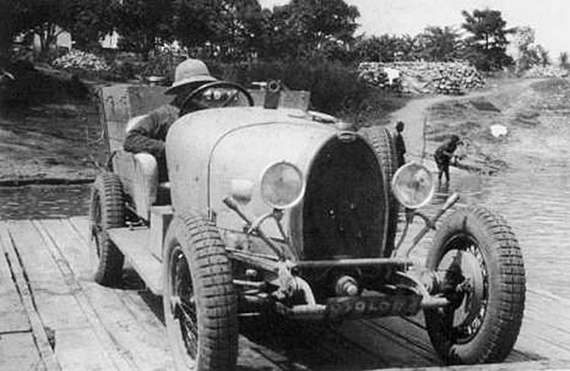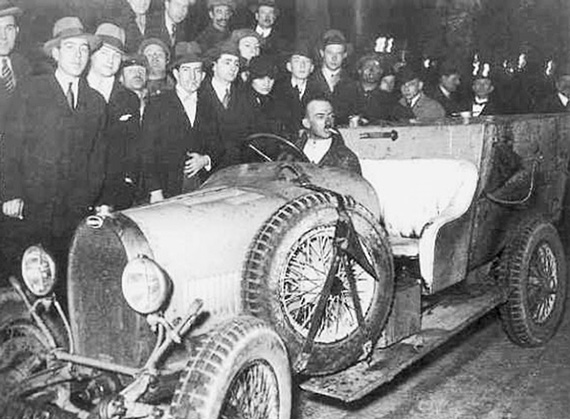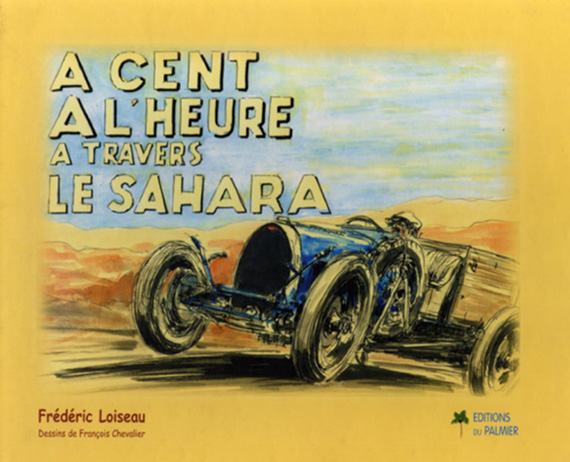
In 1930 Lieutenant Frédéric Loiseau wrote a book about his adventure “A cent à l’heure à travers le Sahara” . A few years ago this book was republished by Editions Le Palmier; It is a delightful book with splendid drawings by the French artist François Chevalier. .
Story by Gijsbert-Paul Berk
Crossing in 1929 the Sahara with Bugatti Type 40: 11,500 kilometers of unpaved roads and desert
In 1927, Lieutenant Frédéric Loiseau, served with the 4th French Army Corps in North Africa. One day an acquaintance, who was the manager of a bank in Tunis, let him drive his supercharged Bugatti. This gave Loiseau the idea for a super-fast automobile link between French-administered territories. These powerful and light Bugattis were potentially much better for such a task than the heavy Citroën autochenille (half-tracks), which had crossed the desert in 1924.
Loiseau convinced his superior, the Resident General in Tunisia and set out to visit Ettore Bugatti in Molsheim. He persuaded Bugatti of the usefulness of a 15,000 km (9300 mile) expedition through the Northern African deserts, and on 25 January, 1928 Bugatti sent Loiseau a contract, with the conditions to supply five Type 40 chassis. These would be equipped with a 10 CV four cylinder engine, a lightweight plywood, “camionette” type body, but no mud guards, two 130-liter fuel tanks a 20-liter oil tank with a hand pump (as on the racing cars), The engine would have a straight-through exhaust and the cooling system would incorporate a water recuperating installation (condenser). Dry weight would be kept below 750 kilograms.
When on January 27, 1929 the convoy of the five Bugatti 10 CV Type 40 assembled, and each of the cars carried a load of at least 800 kilograms. About half of this consisted of the personal luggage of the participants. Loiseau had voiced his misgivings about the overloading. He intended to do a record-run from Paris to the Côte d’Ivoire and back.
In the afternoon of the 29 January the group arrived at Oran, where they got an official reception and in the evening they officially started for Colomb-Bechar, where they had to face the first sand-passages which were the first difficulties for the overloaded vehicles. But as most of the participants did not want to leave their personal belongings they bought a truck to join the convoy!
Loiseau and a second team left the convoy to travel faster. Driving on, they met the Renault driver Georges Estienne. He was accompanied by the Marshall Franchet d’Esperey who had already crossed the Sahara before with the brothers Estienne. As Estienne-being familiar with the route-drove during the day but also through parts of the night, his average was not much slower than that of Loiseau and his team mate. The two Bugatti drivers had to stop after sunset.
The three other Bugatti teams proceeded at a considerably slower pace. Somewhere near Tanezrouft the additionally purchased truck – with its load of personal luggage- had to be left behind because of a technical failure. For Loiseau this would later prove to be a stroke of luck. On his way back he came across the abandoned truck and its tank proved to be it a welcome “fuel reserve”.
From the oasis of Gao onward, Loiseau drove alone.
According to an article which was published in the ‘Le Monde Coloniale Illustré” (1929) his stages were:
13 February: Gao-Niamey, 480 kms in 8 hours and 30 minutes. Average speed: 56 km/h
14 February: Niamey-Fada N’Gourma, 350 kilometers in 5h30′. Average speed: 64 km/h
15 February: Fada N’gourma – Ouagadougou, 235 kilometers in 3h30′. Average speed (deducted half an hour rest): 78 km/h
16 February: Ouagadougou – Bobo Dioulasso, 365 kilometers in 5h45′. Average speed: 63 km/h. On this stage of the journey Loiseau meets Andre Labouret who he knows – they decide to continue the journey together.
17 February: Bobo Dioulasso – Bouake, 475km in 6h10′. Average speed: 77km/h
18 February: Bouake – Grand Bassam, 55km, including a deviation of 110km since he followed the wrong track, in 11h30′. Average speed: 48 km/h
19 February: Rest in Grand Bassam. A 60 km drive to visit friends in Biggerville (near Abidjan) in the afternoon.
20 February: Start of the return journey direction Odienne. Due to a destroyed bridge and several river crossings by use of a ferry only 210km can be done in a total time of 12h30′. Average speed: 25km/h
21. and 22. February: Start on 21 at 03:00hrs, drive via Odienne direction Kankan; very difficult driving conditions and an enforced rest due to another river-crossing. Rest on 22. at 02:45hrs. Nearly 900kms have been driven in 23h15′. Average speed: 38km/h
22. February: Drive from Kankan to Bamako. 460 km in 13h. Average speed: 35km/h
23. February: One day rest in Bamako.
24./25. February: Bamako – Goundam. Loiseau and Labouret used a new, only little frequented track, which starting from Segou followed the left bank of the river Niger via Massina, Niafunke and Goundam to Timbuktu. 900 kilometers in 23h45′. Average speed: 38km/h
26. February: Goundam – Timbuktu – Gao. Some hours for rest in Timbuktu. 650 km (out of which 50 were a deviation) in 15 hours. Average speed (including the rest(: 45km/h
27. February: Rest day in Gao
28. February: Start at 01:00hrs to cross the Tanezrouft. From Gao on, Comte de Ponfilly is on board as a passenger.
1. March: Arrival in Adrar at 19:00hrs. The distance of 1’500 kilometers was completed in 42 hours, thereof 9 hours were taken as a rest. Average speed (without the rest): 45 km/h
2. March: Adrar – Fort Mac Mahon, 400 kms in 9h30′. Average speed: 42 km/h.
3. March: Fort Mac Mahon – Gardaia, 565 km in 15h30′. Average speed: 36 km/h
4. March: Ghardia – Algiers. Arrival in Algiers in the night from 4. to 5. March. Delay due to a crash with another vehicle on the road. Lenght of the last stage: 650 kilometers.
In about five weeks, Loiseau and his Bugatti managed to cover a distance of approximately 11’500 kilometers and crossed the Sahara twice. Although there were several narrow escapes, Loiseau and his Bugatti survived the Sahara adventure without any serious problems. Loiseau had to fight a continuous fight against sleep. One time he fell asleep at the steering wheel and was replaced by one of his team mates, who then immediately fell to asleep as well! Another time at a speed of about 100km/h, he did not see a small trench and the car just jumped over it without an accident. Pure luck!
Although the French army never purchased Bugattis and the project of fast automobile link between French-administered territories in North Africa was never realized, the newspaper coverage of and the resulting publicity about the Sahara crossing by these relatively small Bugattis were very positive for the marque in Molsheim.
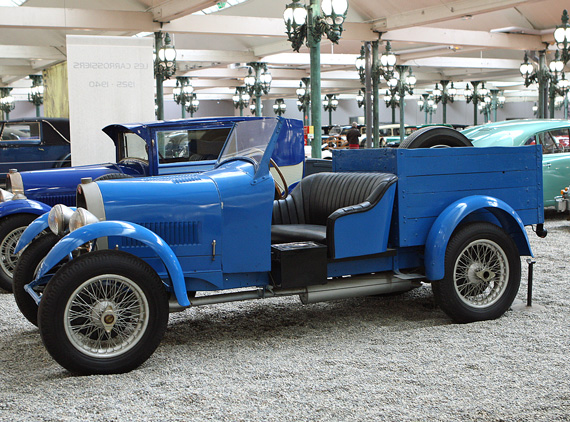
The Type 40 Camionette in the Cite de l’Automobile at Mulhouse is claimed to be the only surviving example of the five cars modified for Loiseau’s expedition. But the body differs considerably from the period photos taken in 1929. Photo by Jonathan Sharp..
Bugatti Type 40 (1926 – 1930)
Units built: approx. 800
Engine: 4-cylinder in-line engine, 3 valve/cylinder, overhead camshafts
Cubic capacity : 1496 cc /
Bore stroke in mm: 69 × 100
Compressor: no
Carburetor: 1 Zenith
Power (at revolutions/min]: 45 @ 4000 rpm
Forward gears: 4
Speed: 115 km/h
Drive: transmission shaft-driven
Front suspension: live axle, semi-elliptic springs
Rear suspension: live axle, inverted quarter-elliptic springs
Brakes: Cable drum brakes
Wheelbase (centimeters): 256 and 271
Wheel Track (centimeters) 120
Tire size : 27 × 4.4
Weight (kilograms): approx. 900
Related Articles:
An Ode to Three Bugattis
Bugatti T40 Across the Sahara
Bugatti T40 Book Review
